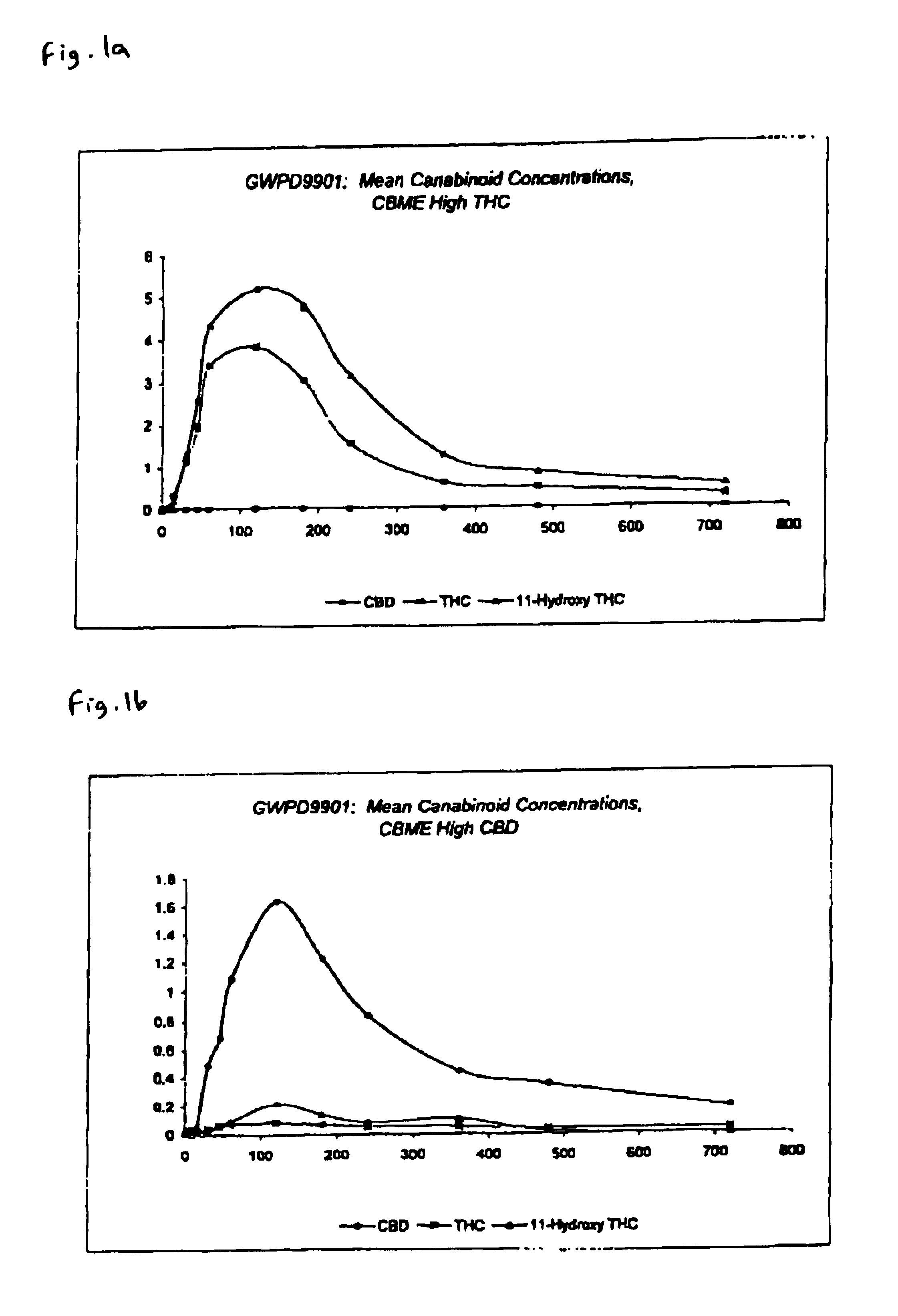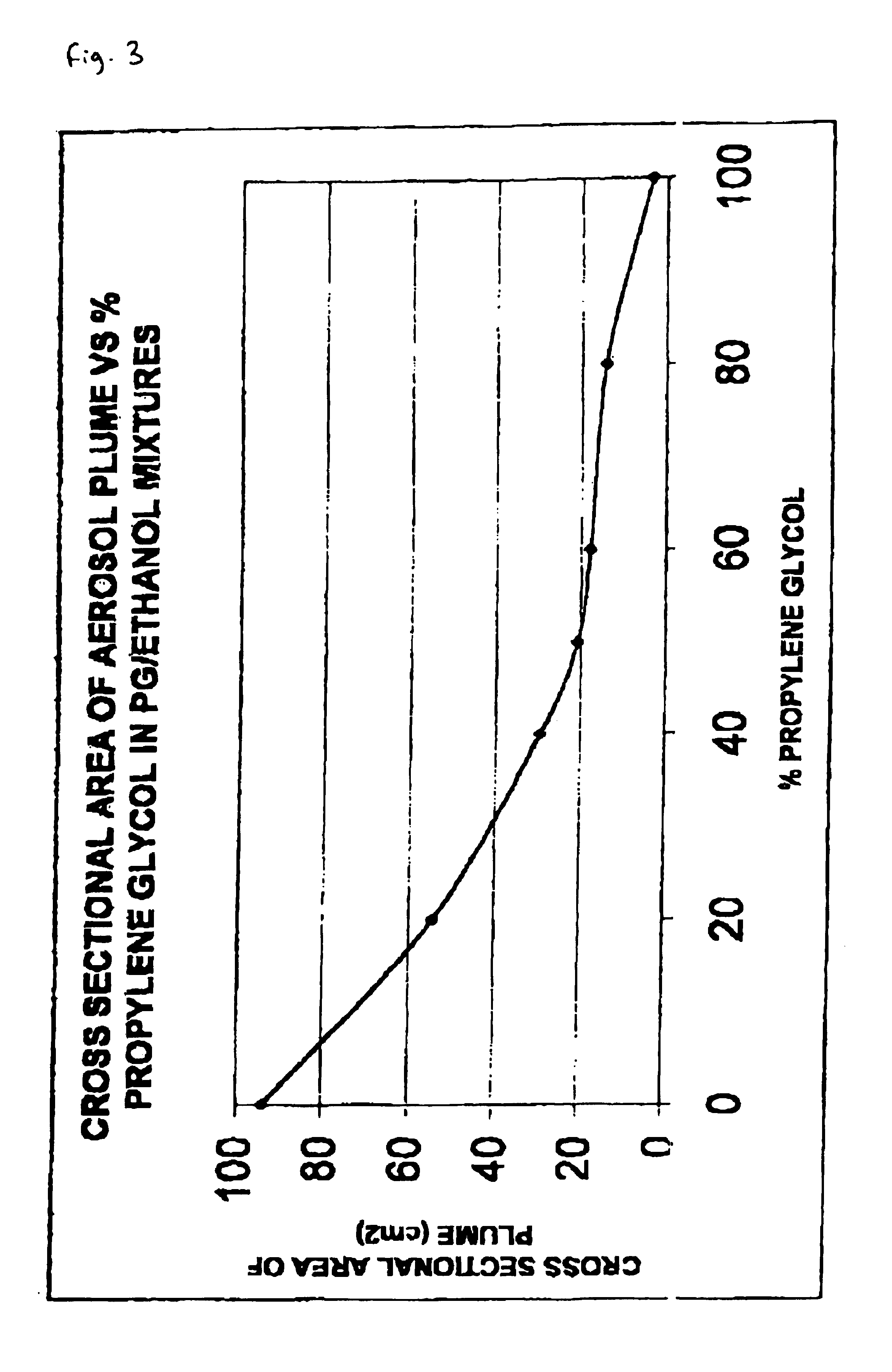Pharmaceutical formulation
- Summary
- Abstract
- Description
- Claims
- Application Information
AI Technical Summary
Benefits of technology
Problems solved by technology
Method used
Image
Examples
example 1
Significance of Particle Size
[0110]Applicant observed that the propellant aerosols that were developed suffered from “bounce back” and this appeared to be a function of delivery speed and particle size.
[0111]Applicant determined that, in contrast to the propellant driven system, a pump spray could deliver an aerosol plume in which the particle size could be controlled to generate a particle size of between 20 and 40 microns (thus maximising the amount of material hitting the sublingual / buccal mucosa and thus the amount of cannabinoids that can be absorbed). To produce particles of the appropriate size the viscosity of the formulation needed to be carefully controlled. If the formulation was too viscous droplet formation was hindered, a jet formed and the valve blocked; If the formulation was not viscous enough they got excessive nebulisation, a plume of broad cross sectional area formed, and the spray was no longer directed solely onto the sublingual / buccal mucosa. This could result...
example 2
Effect of Water when the Cannabinoids are Present in a BDS.
[0124]The presence of greater than 5% water in the formulation was shown to cause precipitation of the BDS as illustrated by the investigation described in Table 7 below:
[0125]
TABLE 7Sequential addition of water was made to 5 ml 25 mg / ml THC and5 ml 25 mg / ml CBD in an ethanol / propyleneglycol formulate (50 / 50).FinalVol of watervolApprox final solvent ratio % voladded mlmlWater / propylene glycol / ethanolobservation050 / 50 / 50Solution0.055.051 / 49.5 / 49.5Ppt forms butredissolves onmixing0.215.265 / 47.5 / 47.5Ppt forms.Solutionremains cloudyafter mixing
Indeed because of this observation the use of anhydrous ethanol is preferred.
Example formulations (non-limiting) according to the invention are as follows:
[0126]
COMPONENTAMOUNT PER UNIT (1 ml)FUNCTIONCOMPOSITION 1 (General)ActiveTHC (BDS)25-50mg / mlActiveCBD (BDS)25-50mg / mlExcipientPropylene Glycol0.5ml / mlCo solventPeppermint oil0.0005ml / mlFlavourEthanol (anhydrous)qs to 1mlSolventCOMPOSITI...
example 3
[0127]The following example illustrates the application of liquid spray formulations to the buccal mucosae and the blood levels produced by buccal absorption in comparison with sublingual administration.
[0128]The following liquid formulations suitable for buccal administration contain self-emulsifying agents, and hence do not fall within the scope of the present invention. Nevertheless, the general principles illustrated by use of these compositions applies equally to the delivery formulations according to the invention. Solutions were produced by dissolving (at a temperature not exceeding 50° C.) the following ingredients (quantitative details are expressed as parts by weight):
[0129]
ABCDEGlyceryl monostearate2—2—2(self-emulsifying)Glyceryl monooleate—2—2—(self-emulsifying)Cremophor RH402030302030CBME-G1 to give THC510———CBME-G5 to give CBD——510—CBME-G1 and G5 to give————10 eachTHC & CBDα-Tocopherol0.10.10.10.10.1Ascorbyl palmitate0.10.10.10.10.1Ethanol BP to produce100100100100100
[...
PUM
| Property | Measurement | Unit |
|---|---|---|
| Length | aaaaa | aaaaa |
| Fraction | aaaaa | aaaaa |
| Density | aaaaa | aaaaa |
Abstract
Description
Claims
Application Information
 Login to View More
Login to View More - R&D
- Intellectual Property
- Life Sciences
- Materials
- Tech Scout
- Unparalleled Data Quality
- Higher Quality Content
- 60% Fewer Hallucinations
Browse by: Latest US Patents, China's latest patents, Technical Efficacy Thesaurus, Application Domain, Technology Topic, Popular Technical Reports.
© 2025 PatSnap. All rights reserved.Legal|Privacy policy|Modern Slavery Act Transparency Statement|Sitemap|About US| Contact US: help@patsnap.com



